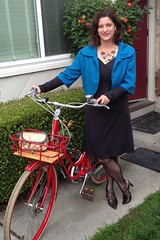Because of attention this blog has received from dedicated readers like you, I’m getting requests for stories from other media outlets. I’ve been writing a thrice-monthly Bike Fun blog for Mountain View Voice since May. Starting next week I will be contributing to Pedal Love, a California-based site dedicated to the joy of bicycling. And soon, one of my bike travel stories will be featured on Adventure Cycling’s Bike Overnights. Occasionally, I’ll cross-post content here, but to keep up with all I write, please bookmark these sites or follow me on Twitter. For those dealing with holiday shopping (and traffic), here’s my latest from Bike Fun in the Voice.
For the vast majority of my shopping trips, my bikes do a great job. Between a pair of oversized panniers in the back and an ample basket in the front, I can carry up to three bags of groceries filled to up to 40 pounds. I’ve also figured out how to attach garment bag to my rear rack for dry cleaning or for buying clothing at the mall. You’d be surprised how easy it can be to carry things on a bike if you’re creative.
But every once in a while I make one of those shopping trips where what I’m buying something too heavy or too bulky for my bike alone. So last year I asked Santa for a cute little bike cargo trailer. It felt a little frivolous. After all, we have a car we can use for those rare, big load shopping trips.

But now that I have the trailer, I realize it’s pretty darn useful. Especially during those times, like right now, where driving to the mall or shopping center is painful and parking is a nightmare. So when our microwave gave up the ghost last week, I hitched up my little trailer and pedaled over to a few big box stores for some comparison shopping, holiday shoppers be damned.

Target, Costco and Best Buy are all within 2-3 miles from home and it wasn’t tough to plot a route that hit them all. Before I left home, I checked online for what each store carried and read the product reviews, but I wanted to buy locally so I could have a replacement immediately. You’d be surprised how some microwaves had really poor ratings after hundreds of reviews, by the way.
With the critical consumer data in hand, my little trailer and I rolled out in search of an oven with all the features I wanted, in the color I wanted and sized to fit my countertop. It took visiting all three stores, but I found the perfect oven. I probably should have measured to see if the box would fit in my trailer before checking out, but it fit nicely with several inches to spare. The ride home was delightfully uneventful and my new microwave fits my kitchen as well as it fit my trailer. Thank you, Santa, for my fun bike toy.

If you’re new to or haven’t done much shopping by bike, here are some tips:
- A rear rack with large panniers can carry more than you think. Most are built to carry 40 pounds or more.
- Front baskets are great for overflow items, but be aware that heavy items up front can affect steering.
- Bring bungee cords for securing bulky items on top of the rear rack or to secure them in a front basket. A deep pothole or hard bump can bounce your purchases right off of your bike.
- Treat packing your purchases on your bike like a working a puzzle. Sometimes I'm sure I've bought too much, but it always works out. Knock on wood, I've never had to return anything.
- If it’s dark or dim out, make sure your purchases don’t block your bike lights.
- Bike trailers don’t have to be expensive. My cargo trailer cost $250 new and is holding up well after a year. Another alternative is buying a used child trailer from someone whose kids have outgrown it.
- Parking can be more challenging for bikes with trailers. Bike racks are designed for single bikes and many are placed without enough room for the extra length of trailers. Bring an extra lock to secure the trailer, either to the bike or to the bike rack.
What’s the most awkward thing you’ve purchased by bike? What made it tough? What made it work?





































